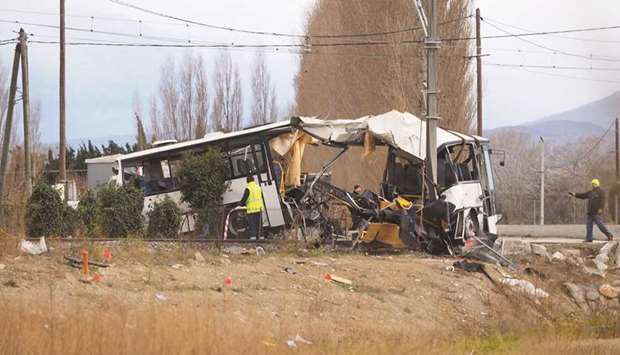Investigators tried yesterday to reconstruct the seconds before a train ploughed into a school bus at a level crossing in southern France and killed at least five children, an incident the prime minister described as “horrific”.
“The families of those caught up in the accident are going through something absolutely terrible,” said Prime Minister Edouard Philippe, who visited Millas on Thursday.
The collision on Thursday afternoon ripped the bus apart and authorities worked into the night to identify the first victims.
The official death toll came after a source close to the investigation earlier said six youngsters had lost their lives in an incident that stunned the small community of Millas, near Perpignan.
Four teenagers died on Thursday and a fifth died yesterday.
Fifteen other children, all aged between 11 and 17, were injured when the bus was torn in two and the train pulled off its rails in France’s worst accident involving a school bus in France for three decades.
The bus driver and three train passengers were also hurt.
Hospitals appealed for blood to help them treat seven children who remain in a critical condition.
Government spokesman Benjamin Griveaux said the cause of the crash was still unclear.
It occurred at a crossing which was not considered dangerous.
Investigators are looking into whether the automatic barriers and lights on the level crossing malfunctioned and have taken blood samples from the driver for toxicology studies, French media reported.
The driver, a 49-year-old woman who was injured in the collision, was described “lucid” by the manager of the bus company in an interview with BFM TV.
The bus was well-maintained, he added.
The train was carrying 25 passengers and travelling at 80kph, the regulatory speed for the section of track where the collision occurred, the national SNCF railway said.
The manager of the bus company, Christian Faur, told French media he had spoken to the driver, whom he described as “experienced”.
“She explained to us that she had crossed the level crossing calmly and confidently [with] the barriers open and the alert lights off,” he told French media.
SNCF said it was shocked by Faur’s comments “at a time when the priority is ... for solidarity with the victims, their families and their friends”.
His “particularly serious accusations” were “formulated without any tangible evidence”, the company said.
Earlier yesterday, Transport Minister Elisabeth Borne said that she hoped separate judicial and administrative investigations could quickly provide “the first indications” of what led to the crash.
“Let’s respect the families’ grief,” Borne told broadcaster Europe 1.
“We owe the truth to the families, and that will be the purpose of the judicial investigation: to determine who is responsible,” Borne said.
Most of the students were from the local Christian Bourquin junior high school, where pupils were in shock as they headed in yesterday.
“I went to sleep at two or three in the morning. I was watching the news, I wasn’t able to sleep,” said teenager Lorena Garcies, dressed in black.
Her cousin and another friend were on the bus, but escaped with broken bones and trauma.
“I’m trying to be strong for them,” she said.
Samuel Conegero, the father of one of the children who survived the accident, said his son took a photo showing “the barriers were lifted” when the bus drove into the path of the incoming train.
“We will obviously consider malfunctions of all kinds,” senior police official Jean Valery Letterman told AFP. “This will take time.”
However, most witnesses questioned so far about a deadly crash have said that the barriers on the level crossing where it took place were closed, according to the prosecutor in charge of investigation.
“The witness statements about the functioning of the barriers are not all in agreement, but a large majority of those taken so far indicate that the barriers were closed,” prosecutor Xavier Tarabeux said yesterday.
At the school, Sabrina Mesas, hugging her daughter Lilou whose best friend was lightly injured in the crash, was struggling to fight back tears.
“We’re in total shock,” Mesas said. “It’s important that everyone is together, that they can talk, to put into words what has happened.”
A psychological support team was on site and students were encouraged to come into school – the authorities do not want them to face the tragedy alone, said Abdelkader Taoui, a doctor who was had been sent to help.
Teachers have also been left stunned. “I don’t even know how to get on with things,” said Jordi Sales, who teaches Catalan and Spanish at the school near the Spanish border.
Robert Olive, mayor of neighbouring Saint-Feliu-d’Amont which was home to all of the children who lost their lives, described the accident site as a “vision of horror”.
Villagers were walking around in tears.
“The kids were what brought the village alive,” said local baker Pierre Alvarez.
He has taken down the Christmas decorations at his store.
The accident is the worst involving a school bus in France since 1987, when 53 people including 44 children were killed in a pile-up involving two coaches that were taking students to a summer camp.

Towing service workers stand next to the wreckage of school bus in Millas, near Perpignan, southern France, yesterday, a day after an accident when a train crashed into the school bus at a level crossing.


